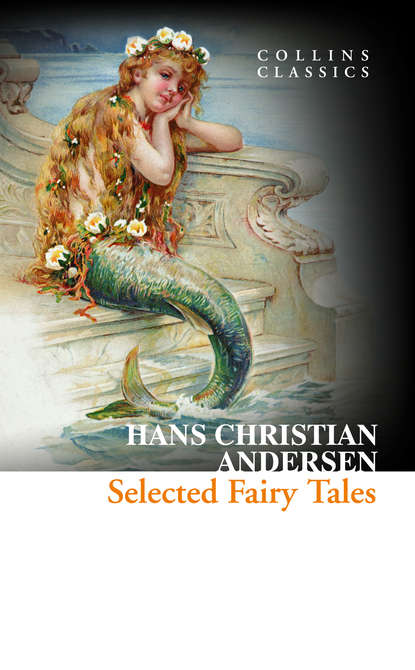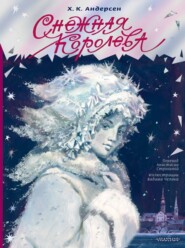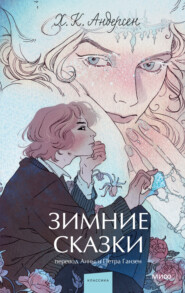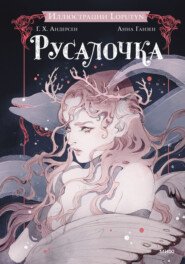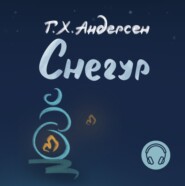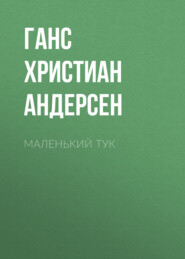По всем вопросам обращайтесь на: info@litportal.ru
(©) 2003-2024.
✖
Selected Fairy Tales
Автор
Год написания книги
2019
Настройки чтения
Размер шрифта
Высота строк
Поля
Selected Fairy Tales
Hans Christian Andersen
HarperCollins is proud to present its new range of best-loved, essential classics.‘It doesn’t matter if you’re born in a duck yard, so long as you are hatched from a swan’s egg!’ (from ‘The Ugly Duckling’)This collection brings together some of Hans Christian Andersen’s most popular fairy tales – including ‘The Little Mermaid’, ‘The Ugly Duckling’ and ‘Thumbelina’ – in a celebration of one of the world’s most widely recognised children’s authors. With universal themes and dark humour at their heart, these moralistic tales have delighted readers since first publication in the nineteenth century and continued to be well loved today.The fairy tales of Hans Christian Andersen, a storyteller of great importance to Western literature, have inspired many films, ballets and plays, and entertained generations of children and adults alike.
SELECTED FAIRY TALES
Hans Christian Andersen
Copyright (#ulink_c4ee5a0a-ac4e-5f89-90c7-c120110d93b0)
William Collins
An imprint of HarperCollinsPublishers
77–85 Fulham Palace Road,
Hammersmith, London W6 8JB
WilliamCollinsBooks.com (http://WilliamCollinsBooks.com)
This eBook edition published by William Collins in 2014
Life & Times section © HarperCollinsPublishers Ltd
Silvia Crompton asserts her moral right as author of the Life & Times section
Classic Literature: Words and Phrases adapted from Collins English Dictionary
Cover by e-Digital Design
Cover image: Little Mermaid, by Hans Christian Andersen (1805–75) (colour litho), Hardy, E. S. (19th century) / Private Collection / The Bridgeman Art Library
A catalogue record for this book is available from the British Library.
All rights reserved under International and Pan-American Copyright Conventions. By payment of the required fees, you have been granted the non-exclusive, non-transferable right to access and read the text of this e-book on-screen. No part of this text may be reproduced, transmitted, down-loaded, decompiled, reverse engineered, or stored in or introduced into any information storage and retrieval system, in any form or by any means, whether electronic or mechanical, now known or hereinafter invented, without the express written permission of HarperCollins.
Source ISBN: 9780007558155
Ebook Edition © August 2014 ISBN: 9780007558162
Version: 2014-07-30
History of Collins (#ulink_a26f2ca5-7a47-5cc5-a72f-1ae13829eab6)
In 1819, millworker William Collins from Glasgow, Scotland, set up a company for printing and publishing pamphlets, sermons, hymn books, and prayer books. That company was Collins and was to mark the birth of HarperCollins Publishers as we know it today. The long tradition of Collins dictionary publishing can be traced back to the first dictionary William published in 1824, Greek and English Lexicon. Indeed, from 1840 onwards, he began to produce illustrated dictionaries and even obtained a licence to print and publish the Bible.
Soon after, William published the first Collins novel, Ready Reckoner; however, it was the time of the Long Depression, where harvests were poor, prices were high, potato crops had failed, and violence was erupting in Europe. As a result, many factories across the country were forced to close down and William chose to retire in 1846, partly due to the hardships he was facing.
Aged 30, William’s son, William II, took over the business. A keen humanitarian with a warm heart and a generous spirit, William II was truly “Victorian” in his outlook. He introduced new, up-to-date steam presses and published affordable editions of Shakespeare’s works and ThePilgrim’s Progress, making them available to the masses for the first time. A new demand for educational books meant that success came with the publication of travel books, scientific books, encyclopedias, and dictionaries. This demand to be educated led to the later publication of atlases, and Collins also held the monopoly on scripture writing at the time.
In the 1860s Collins began to expand and diversify and the idea of “books for the millions” was developed. Affordable editions of classical literature were published, and in 1903 Collins introduced 10 titles in their Collins Handy Illustrated Pocket Novels. These proved so popular that a few years later this had increased to an output of 50 volumes, selling nearly half a million in their year of publication. In the same year, The Everyman’s Library was also instituted, with the idea of publishing an affordable library of the most important classical works, biographies, religious and philosophical treatments, plays, poems, travel, and adventure. This series eclipsed all competition at the time, and the introduction of paperback books in the 1950s helped to open that market and marked a high point in the industry.
HarperCollins is and has always been a champion of the classics, and the current Collins Classics series follows in this tradition – publishing classical literature that is affordable and available to all. Beautifully packaged, highly collectible, and intended to be reread and enjoyed at every opportunity.
Life & Times (#ulink_8406fd69-41ca-566a-a1c9-0af34f01ffe4)
It is almost impossible nowadays to pass through childhood without the companionship of Hans Christian Andersen’s fairy-tale creations: the plucky Ugly Duckling, the beautiful Little Mermaid, the foolish Emperor in his ‘new clothes’. A welcome salve to the gorier excesses of the Brothers Grimm, Andersen has for almost two centuries enchanted children – and adults – as a satirist, teller of fantastical tales, moral guide and bringer of hope into the bleakest of beginnings. But for one so treasured by his readers, Andersen led a life of remarkable solitude: he dragged himself from rags to riches and drew widely on the experience in his stories, but he was never able to shake off the mantle of lonely eccentric – a man much admired but rarely loved. His was, in effect, a fairy tale without the happy ending.
The Danish Dickens
Andersen knew he had made it as a writer during an 1847 visit to England, where he was invited to a grand society party and introduced to Charles Dickens. The great novelist, described in Andersen’s diary as ‘the living English writer whom I love the most’, appeared just as captivated by his Danish counterpart and the two began a correspondence that lasted ten years.
As an author, Andersen shared a number of themes with Dickens – notably childhood, poverty, social injustice and reversals of fortune – and in later life both men carved out second careers giving wildly popular public readings, but Andersen had in addition suffered an upbringing worthy of a Dickensian hero. Born in Odense, Denmark, in 1805, he was the only child of a shoemaker and a washerwoman of no fixed address. He made sporadic appearances at charity schools until the age of eleven, when he was forced by his father’s death to find work, first at a cloth mill and then a tobacco factory. Determined to escape the crippling poverty into which he had been born, he stowed away in a wagon bound for Copenhagen at the age of just fourteen, hoping to find his fortune.
Luck and Perseverance
That Andersen was able to become the author of his own destiny is thanks in large part to a series of fortuitous encounters along the way, beginning with his father, Hans. The young Andersen may have been an unenthusiastic schoolboy, but in the evenings Andersen Senior instilled in him a passion for extraordinary stories, reading to him from the Arabian Nights, the fables of Jean de la Fontaine and the Bible – though one of his favourite yarns, unproven to this day, was that the family was descended from Danish nobility. Even when he was sent out to make money, the boy enjoyed sharing folk tales with his adult co-workers, many of which influenced the stories he went on to write.
Life in Odense was certainly hard, but Denmark’s second city was at least large enough to have its own theatre – one that attracted travelling performers from the Royal Theatre in Copenhagen – and Andersen made his first visit there aged seven. By the time he arrived in the capital in 1819, his only dream was to join the theatre as a dancer, singer, actor or writer.
The dream almost foundered on day one, when Andersen performed a disastrous ballet audition at the Royal Theatre and was thrown out. Armed with a letter of recommendation from an Odense printer, however, he persisted in his attempts to infiltrate the institution and was rewarded with a place at the School of Singing and Dance – a place that was revoked nine months later when his voice began to break. Still he refused to leave, enduring a string of non-speaking stage roles while improving his reading and writing. In turning down Andersen’s first play in 1822, one director remarked that the boy nevertheless showed ‘an unmistakable aptitude for writing’.
That same year, the Royal Theatre finally gave Andersen a break. Though his second play was likewise turned down, the rejection came with a recommendation that he be sent to grammar school for a proper education. Having arranged for him to receive a generous grant, the theatre’s director became his guardian and mentor, overseeing his seven years at school and university. Of greatest value during this time, however, was Andersen’s acquaintance and then friendship with the lecturer B.S. Ingemann, who in 1820 had published Denmark’s greatest collection of fairy tales – an accolade his protégée would soon usurp.
Fairy Tales
In February 1835 Andersen wrote to Ingemann: ‘I have started some fantastic tales for children and believe I have succeeded. I have told a couple of tales which as a child I was happy about, and which I do not believe are known, and have written them exactly the way I would tell them to a child.’ His first collection of ‘eventyr’ (‘fantastic tales’) appeared later that year. (‘Fairy tale’ comes from the ‘contes de fées’ of a French writer, Madame d’Aulnoy, in the late seventeenth century.)
Unlike the Brothers Grimm, whose fairy tales, published during Andersen’s childhood, were almost exclusively based on ancient German folk stories, Andersen’s ‘eventyr’ took their inspiration from a wide range of sources. Some, such as ‘The Princess and the Pea’, were taken from tales he had heard as a boy; others, including ‘The Emperor’s New Clothes’ and ‘Thumbelina’, were adapted from foreign stories – a medieval Spanish tale and the English ‘Tom Thumb’ respectively. But Andersen was above all a master of invention: some of his greatest tales, including ‘The Little Mermaid’ and ‘The Ugly Duckling’, were entirely his own, while ‘The Little Match Girl’ was inspired by a popular woodcut.
Critics derided the 1835 collection for its simplistic language, and sales would have discouraged anyone other than the resilient Andersen, who instead continued to hone his craft and publish. By 1843, when he produced his masterpiece, ‘The Ugly Duckling’, his fairy tales were, in his own words, ‘selling like hot cakes’.
The Ugly Duckling
A regular guest at palaces and parties, Andersen was feted wherever he went; in 1866 he was granted the freedom of the city of Odense, despite having rarely gone back. But he never lost the social awkwardness he’d carried with him since his sudden rise to fame; he once joked that ‘The Ugly Duckling’ was the story of his life, but in reality he never quite learned to fit in.
Andersen never married, though not for want of trying. He fell hopelessly, unrequitedly in love with a string of unattainable women as well as men. His ill-at-ease social presence bemused and frustrated his friends, not least Charles Dickens, whom Andersen riled in 1857 with a seemingly endless visit; five weeks after his arrival at the Dickens family home, he had to be asked to leave. ‘He was a bony bore,’ Dickens’ daughter reported, ‘and he stayed on and on.’ In the ten years since their first meeting, Dickens had used a thinly veiled caricature of Andersen in David Copperfield: the ‘high-shouldered and bony’ clerk Uriah Heep.
Nevertheless, the quality of Andersen’s imagination and writing made him a national treasure and an international celebrity. In 1875, the year of his death, one London newspaper declared that his fairy tales ‘deserve a place in the pantheon where Homer and Shakespeare live forever’.
Andersen died in August 1875 at Rolighed (‘Calmness’), the home of a close friend. His funeral drew a large and eclectic crowd, from the king and crown prince down to representatives of the Workers’ Association for whom he had performed numerous readings. Since 1967 his birthday, 2 April, has been celebrated as International Children’s Book Day, although Andersen maintained to the end that his stories were written for everyone. ‘My fairy tales were just as much for adults as for children, who only understood the ornamental trappings,’ he wrote in his diary shortly before his death, ‘but only as mature adults can they see and perceive the contents. The naive was only one part of my fairy tales; the humour was the actual zest in them.’
CONTENTS
Cover (#ue6f8ede2-1bb3-5660-b09f-cb5ab042a438)
Title Page (#u3186f9bd-1944-54a4-8d31-7bff0543aa44)
Copyright (#u3644b5b1-d972-5d4d-bffe-4081774c9dd2)
Hans Christian Andersen
HarperCollins is proud to present its new range of best-loved, essential classics.‘It doesn’t matter if you’re born in a duck yard, so long as you are hatched from a swan’s egg!’ (from ‘The Ugly Duckling’)This collection brings together some of Hans Christian Andersen’s most popular fairy tales – including ‘The Little Mermaid’, ‘The Ugly Duckling’ and ‘Thumbelina’ – in a celebration of one of the world’s most widely recognised children’s authors. With universal themes and dark humour at their heart, these moralistic tales have delighted readers since first publication in the nineteenth century and continued to be well loved today.The fairy tales of Hans Christian Andersen, a storyteller of great importance to Western literature, have inspired many films, ballets and plays, and entertained generations of children and adults alike.
SELECTED FAIRY TALES
Hans Christian Andersen
Copyright (#ulink_c4ee5a0a-ac4e-5f89-90c7-c120110d93b0)
William Collins
An imprint of HarperCollinsPublishers
77–85 Fulham Palace Road,
Hammersmith, London W6 8JB
WilliamCollinsBooks.com (http://WilliamCollinsBooks.com)
This eBook edition published by William Collins in 2014
Life & Times section © HarperCollinsPublishers Ltd
Silvia Crompton asserts her moral right as author of the Life & Times section
Classic Literature: Words and Phrases adapted from Collins English Dictionary
Cover by e-Digital Design
Cover image: Little Mermaid, by Hans Christian Andersen (1805–75) (colour litho), Hardy, E. S. (19th century) / Private Collection / The Bridgeman Art Library
A catalogue record for this book is available from the British Library.
All rights reserved under International and Pan-American Copyright Conventions. By payment of the required fees, you have been granted the non-exclusive, non-transferable right to access and read the text of this e-book on-screen. No part of this text may be reproduced, transmitted, down-loaded, decompiled, reverse engineered, or stored in or introduced into any information storage and retrieval system, in any form or by any means, whether electronic or mechanical, now known or hereinafter invented, without the express written permission of HarperCollins.
Source ISBN: 9780007558155
Ebook Edition © August 2014 ISBN: 9780007558162
Version: 2014-07-30
History of Collins (#ulink_a26f2ca5-7a47-5cc5-a72f-1ae13829eab6)
In 1819, millworker William Collins from Glasgow, Scotland, set up a company for printing and publishing pamphlets, sermons, hymn books, and prayer books. That company was Collins and was to mark the birth of HarperCollins Publishers as we know it today. The long tradition of Collins dictionary publishing can be traced back to the first dictionary William published in 1824, Greek and English Lexicon. Indeed, from 1840 onwards, he began to produce illustrated dictionaries and even obtained a licence to print and publish the Bible.
Soon after, William published the first Collins novel, Ready Reckoner; however, it was the time of the Long Depression, where harvests were poor, prices were high, potato crops had failed, and violence was erupting in Europe. As a result, many factories across the country were forced to close down and William chose to retire in 1846, partly due to the hardships he was facing.
Aged 30, William’s son, William II, took over the business. A keen humanitarian with a warm heart and a generous spirit, William II was truly “Victorian” in his outlook. He introduced new, up-to-date steam presses and published affordable editions of Shakespeare’s works and ThePilgrim’s Progress, making them available to the masses for the first time. A new demand for educational books meant that success came with the publication of travel books, scientific books, encyclopedias, and dictionaries. This demand to be educated led to the later publication of atlases, and Collins also held the monopoly on scripture writing at the time.
In the 1860s Collins began to expand and diversify and the idea of “books for the millions” was developed. Affordable editions of classical literature were published, and in 1903 Collins introduced 10 titles in their Collins Handy Illustrated Pocket Novels. These proved so popular that a few years later this had increased to an output of 50 volumes, selling nearly half a million in their year of publication. In the same year, The Everyman’s Library was also instituted, with the idea of publishing an affordable library of the most important classical works, biographies, religious and philosophical treatments, plays, poems, travel, and adventure. This series eclipsed all competition at the time, and the introduction of paperback books in the 1950s helped to open that market and marked a high point in the industry.
HarperCollins is and has always been a champion of the classics, and the current Collins Classics series follows in this tradition – publishing classical literature that is affordable and available to all. Beautifully packaged, highly collectible, and intended to be reread and enjoyed at every opportunity.
Life & Times (#ulink_8406fd69-41ca-566a-a1c9-0af34f01ffe4)
It is almost impossible nowadays to pass through childhood without the companionship of Hans Christian Andersen’s fairy-tale creations: the plucky Ugly Duckling, the beautiful Little Mermaid, the foolish Emperor in his ‘new clothes’. A welcome salve to the gorier excesses of the Brothers Grimm, Andersen has for almost two centuries enchanted children – and adults – as a satirist, teller of fantastical tales, moral guide and bringer of hope into the bleakest of beginnings. But for one so treasured by his readers, Andersen led a life of remarkable solitude: he dragged himself from rags to riches and drew widely on the experience in his stories, but he was never able to shake off the mantle of lonely eccentric – a man much admired but rarely loved. His was, in effect, a fairy tale without the happy ending.
The Danish Dickens
Andersen knew he had made it as a writer during an 1847 visit to England, where he was invited to a grand society party and introduced to Charles Dickens. The great novelist, described in Andersen’s diary as ‘the living English writer whom I love the most’, appeared just as captivated by his Danish counterpart and the two began a correspondence that lasted ten years.
As an author, Andersen shared a number of themes with Dickens – notably childhood, poverty, social injustice and reversals of fortune – and in later life both men carved out second careers giving wildly popular public readings, but Andersen had in addition suffered an upbringing worthy of a Dickensian hero. Born in Odense, Denmark, in 1805, he was the only child of a shoemaker and a washerwoman of no fixed address. He made sporadic appearances at charity schools until the age of eleven, when he was forced by his father’s death to find work, first at a cloth mill and then a tobacco factory. Determined to escape the crippling poverty into which he had been born, he stowed away in a wagon bound for Copenhagen at the age of just fourteen, hoping to find his fortune.
Luck and Perseverance
That Andersen was able to become the author of his own destiny is thanks in large part to a series of fortuitous encounters along the way, beginning with his father, Hans. The young Andersen may have been an unenthusiastic schoolboy, but in the evenings Andersen Senior instilled in him a passion for extraordinary stories, reading to him from the Arabian Nights, the fables of Jean de la Fontaine and the Bible – though one of his favourite yarns, unproven to this day, was that the family was descended from Danish nobility. Even when he was sent out to make money, the boy enjoyed sharing folk tales with his adult co-workers, many of which influenced the stories he went on to write.
Life in Odense was certainly hard, but Denmark’s second city was at least large enough to have its own theatre – one that attracted travelling performers from the Royal Theatre in Copenhagen – and Andersen made his first visit there aged seven. By the time he arrived in the capital in 1819, his only dream was to join the theatre as a dancer, singer, actor or writer.
The dream almost foundered on day one, when Andersen performed a disastrous ballet audition at the Royal Theatre and was thrown out. Armed with a letter of recommendation from an Odense printer, however, he persisted in his attempts to infiltrate the institution and was rewarded with a place at the School of Singing and Dance – a place that was revoked nine months later when his voice began to break. Still he refused to leave, enduring a string of non-speaking stage roles while improving his reading and writing. In turning down Andersen’s first play in 1822, one director remarked that the boy nevertheless showed ‘an unmistakable aptitude for writing’.
That same year, the Royal Theatre finally gave Andersen a break. Though his second play was likewise turned down, the rejection came with a recommendation that he be sent to grammar school for a proper education. Having arranged for him to receive a generous grant, the theatre’s director became his guardian and mentor, overseeing his seven years at school and university. Of greatest value during this time, however, was Andersen’s acquaintance and then friendship with the lecturer B.S. Ingemann, who in 1820 had published Denmark’s greatest collection of fairy tales – an accolade his protégée would soon usurp.
Fairy Tales
In February 1835 Andersen wrote to Ingemann: ‘I have started some fantastic tales for children and believe I have succeeded. I have told a couple of tales which as a child I was happy about, and which I do not believe are known, and have written them exactly the way I would tell them to a child.’ His first collection of ‘eventyr’ (‘fantastic tales’) appeared later that year. (‘Fairy tale’ comes from the ‘contes de fées’ of a French writer, Madame d’Aulnoy, in the late seventeenth century.)
Unlike the Brothers Grimm, whose fairy tales, published during Andersen’s childhood, were almost exclusively based on ancient German folk stories, Andersen’s ‘eventyr’ took their inspiration from a wide range of sources. Some, such as ‘The Princess and the Pea’, were taken from tales he had heard as a boy; others, including ‘The Emperor’s New Clothes’ and ‘Thumbelina’, were adapted from foreign stories – a medieval Spanish tale and the English ‘Tom Thumb’ respectively. But Andersen was above all a master of invention: some of his greatest tales, including ‘The Little Mermaid’ and ‘The Ugly Duckling’, were entirely his own, while ‘The Little Match Girl’ was inspired by a popular woodcut.
Critics derided the 1835 collection for its simplistic language, and sales would have discouraged anyone other than the resilient Andersen, who instead continued to hone his craft and publish. By 1843, when he produced his masterpiece, ‘The Ugly Duckling’, his fairy tales were, in his own words, ‘selling like hot cakes’.
The Ugly Duckling
A regular guest at palaces and parties, Andersen was feted wherever he went; in 1866 he was granted the freedom of the city of Odense, despite having rarely gone back. But he never lost the social awkwardness he’d carried with him since his sudden rise to fame; he once joked that ‘The Ugly Duckling’ was the story of his life, but in reality he never quite learned to fit in.
Andersen never married, though not for want of trying. He fell hopelessly, unrequitedly in love with a string of unattainable women as well as men. His ill-at-ease social presence bemused and frustrated his friends, not least Charles Dickens, whom Andersen riled in 1857 with a seemingly endless visit; five weeks after his arrival at the Dickens family home, he had to be asked to leave. ‘He was a bony bore,’ Dickens’ daughter reported, ‘and he stayed on and on.’ In the ten years since their first meeting, Dickens had used a thinly veiled caricature of Andersen in David Copperfield: the ‘high-shouldered and bony’ clerk Uriah Heep.
Nevertheless, the quality of Andersen’s imagination and writing made him a national treasure and an international celebrity. In 1875, the year of his death, one London newspaper declared that his fairy tales ‘deserve a place in the pantheon where Homer and Shakespeare live forever’.
Andersen died in August 1875 at Rolighed (‘Calmness’), the home of a close friend. His funeral drew a large and eclectic crowd, from the king and crown prince down to representatives of the Workers’ Association for whom he had performed numerous readings. Since 1967 his birthday, 2 April, has been celebrated as International Children’s Book Day, although Andersen maintained to the end that his stories were written for everyone. ‘My fairy tales were just as much for adults as for children, who only understood the ornamental trappings,’ he wrote in his diary shortly before his death, ‘but only as mature adults can they see and perceive the contents. The naive was only one part of my fairy tales; the humour was the actual zest in them.’
CONTENTS
Cover (#ue6f8ede2-1bb3-5660-b09f-cb5ab042a438)
Title Page (#u3186f9bd-1944-54a4-8d31-7bff0543aa44)
Copyright (#u3644b5b1-d972-5d4d-bffe-4081774c9dd2)





